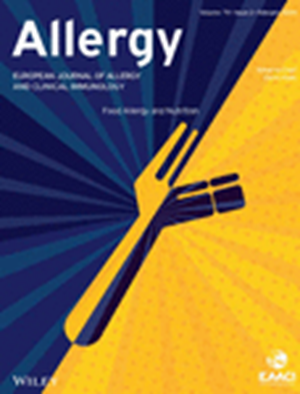IFNγ信号通路损害B细胞调节功能导致食道食物过敏控制恶化
IF 12
1区 医学
Q1 ALLERGY
引用次数: 0
摘要
嗜酸性粒细胞性食管炎(EoE)是一种慢性食物过敏,可引起食管炎症和纤维化,表现为反流、胸痛、吞咽困难和食物嵌塞等症状。虽然EoE的患病率以每年约15%的速度增长,但我们对EoE免疫病理学的了解有限。EoE的一个显著特征是血液循环和食管组织中存在食物特异性IgG4抗体。在其他过敏性疾病中,IgG4的产生仅限于IL-10+ B细胞(Bregs),提示Bregs可能存在于EoE中。方法对EoE牛奶过敏患者进行循环Bregs检测。同时,我们对Bregs在食物抗原依赖性EoE小鼠模型中的作用进行了机制研究。采用流式细胞术和组织学分析评估食管和引流淋巴结免疫细胞,并采用体外试验评估Breg功能容量。结果在EoE牛奶过敏组和EoE疾病模型中,breg频率均降低。小鼠的Breg抑制能力在eo样炎症中受损。诱导缺失breg来源的IL-10加重了eo样炎症,而过继性转移足够的Bregs IL-10抑制DC激活并改善食管嗜酸性粒细胞增多。IFNγ在体外足以抑制Breg扩增和IL-10的产生,并在体内导致Breg功能障碍和食管炎症。结论在EoE过程中,bregs通过控制食管嗜酸性粒细胞增多发挥免疫调节作用,但由于ifn γ介导的信号通路而功能受损。这些发现对于理解EoE的病因和实施针对IFNγ的未来治疗具有重要意义。本文章由计算机程序翻译,如有差异,请以英文原文为准。
IFNγ Signaling Impairs Regulatory B Cell Function Resulting in Worse Control of Esophageal Food Allergy.
BACKGROUND
Eosinophilic Esophagitis (EoE) is a chronic food allergy that causes esophageal inflammation and fibrosis and manifests with symptoms of reflux, chest pain, swallowing difficulty, and food impactions. Though the prevalence of EoE is increasing by ~15% each year, our understanding of EoE immunopathology is limited. A noted feature of EoE is the presence of food-specific IgG4 antibodies in the circulation and esophageal tissue. Production of IgG4 is confined to IL-10+ B cells (Bregs) in other allergic diseases, suggesting Bregs may be present in EoE.
METHODS
We examined circulating Bregs in patients with EoE milk allergy. In parallel, we performed mechanistic investigations of the role of Bregs in a murine model of food-antigen-dependent EoE. Flow cytometry and histologic analyses were used to assess esophageal and draining lymph node immune cells, and in vitro assays were used to evaluate Breg functional capacity.
RESULTS
Breg frequency was reduced in both EoE milk allergic subjects and an EoE disease model. Murine Breg suppressive capacity was impaired during EoE-like inflammation. Inducible deletion of Breg-derived IL-10 worsened EoE-like inflammation, while adoptive transfer of IL-10 sufficient Bregs suppressed DC activation and improved esophageal eosinophilia. IFNγ was sufficient to suppress Breg expansion and IL-10 production in vitro and contributed to Breg dysfunction and esophageal inflammation in vivo.
CONCLUSION
Bregs play an immunoregulatory role during EoE by controlling esophageal eosinophilia but are functionally impaired due to IFNγ-mediated signaling. These findings have important implications for understanding EoE's etiology and implementing future therapies that target IFNγ.
求助全文
通过发布文献求助,成功后即可免费获取论文全文。
去求助
来源期刊

Allergy
医学-过敏
CiteScore
26.10
自引率
9.70%
发文量
393
审稿时长
2 months
期刊介绍:
Allergy is an international and multidisciplinary journal that aims to advance, impact, and communicate all aspects of the discipline of Allergy/Immunology. It publishes original articles, reviews, position papers, guidelines, editorials, news and commentaries, letters to the editors, and correspondences. The journal accepts articles based on their scientific merit and quality.
Allergy seeks to maintain contact between basic and clinical Allergy/Immunology and encourages contributions from contributors and readers from all countries. In addition to its publication, Allergy also provides abstracting and indexing information. Some of the databases that include Allergy abstracts are Abstracts on Hygiene & Communicable Disease, Academic Search Alumni Edition, AgBiotech News & Information, AGRICOLA Database, Biological Abstracts, PubMed Dietary Supplement Subset, and Global Health, among others.
 求助内容:
求助内容: 应助结果提醒方式:
应助结果提醒方式:


